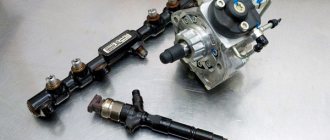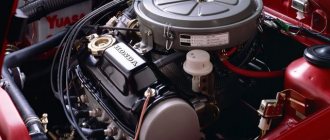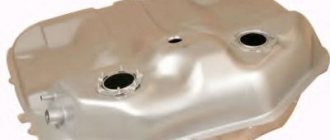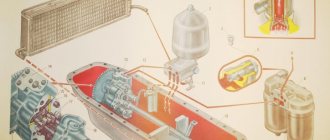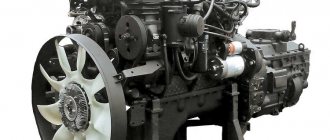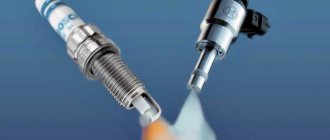Checking the tightness of the engine power system
To check the tightness you need a vacuum gauge. First check the tightness of the system from the fuel tank to the inlet of the fuel filter.
To do this, disconnect the fuel supply line from the fuel filter and connect a vacuum gauge to it. Start the engine and increase the speed to 2000-2500 per minute. The device readings should not exceed 1 kgf/cm2. Otherwise, check whether the fuel lines are damaged (knock them, shake them), and whether the fuel tank strainer and ventilation tube are clogged. 320. Next, check the tightness at the outlet of the fuel filter. Disconnect the fuel line at the fuel filter outlet fitting, attach a vacuum gauge, and start the engine. Increase the crankshaft speed to 2000-2500 rpm. The readings of the device should not exceed 0.25 kgf/cm2. Otherwise, the fuel filter element probably needs to be replaced.
321. There are special testers for checking the tightness of the fuel system. They are convenient due to the presence of adapter tips at the end of transparent hoses.
Diesel engines
Maintenance of the diesel power system. During EO , the power system devices are cleaned of dirt and dust, the fuel level in the tank is checked and, if necessary, the vehicle is refueled. Sludge from the fuel filter-settler (FSF) is drained daily in the cold season, and at intervals that do not allow the formation of sludge in an amount of more than 0.10...0.15 liters in the warm season.
During TO-1, visually check the tightness of the connections of the fuel lines, power system devices and the rubber pipe of the air filter. After examining the condition and operation of the engine stop system and the manual fuel supply control drive, the drives are adjusted. The sediment from the coarse and fine fuel filters is drained, if necessary, the coarse fuel filter cap is washed, after which the engine is started and run for 3...4 minutes to remove air pockets.
During TO-2, the serviceability and complete operation of the fuel supply control mechanism is checked (with the pedal fully pressed, the injection pump rack control lever should rest against the limit bolt). Replace the filter elements of the fine fuel filters, wash the coarse fuel filter, and clean the paper filter element of the second stage of the air filter. Replace the oil in the fuel injection advance clutch and in the fuel injection pump.
During CO , the injectors are removed, the needle lift pressure (using a torque scope) and the fuel injection advance angle are checked and adjusted on the bench. Once every 2 years, the injection pump is removed, its performance is checked on a stand and, if necessary, adjusted in specialized workshops. In preparation for winter operation, fuel tanks are washed.
Malfunctions of the diesel power system. Malfunctions of the diesel engine power system that cause deterioration in its performance include interruptions in operation, difficult starting, uneven operation, decreased engine power, smoky exhaust gases, unstable engine operation and “overrun” (when the engine is difficult to stop).
Difficulty starting the engine occurs as a result of an excessive decrease in pressure during injection and a decrease in fuel supply. These malfunctions arise due to wear of the plunger pair and nozzle nozzle holes, decreased elasticity of the nozzle spring, poor fastening of fittings, clogged filters and pipelines.
The engine runs intermittently if the fittings of the high and low pressure fuel lines are not tightly tightened, the fuel filter caps do not fit tightly (air leaks), the fuel priming pump is faulty, and the adjustment of the amount and uniformity of fuel supply by the sections of the high pressure pump is disrupted.
Engine power decreases due to lack of fuel supply and improper pump adjustment.
Smoky exhaust is a result of excessive fuel supply and poor atomization or improper installation of the high pressure pump and worn piston rings. Excessive fuel supply occurs due to improper adjustment of the high-pressure pump, and poor atomization is due to loss of elasticity of the injector springs, loose needle fit and wear of the nozzle holes.
Runaway engine operation occurs when the rack gets stuck, the rack wire lever spring breaks, and excess oil gets into the combustion chamber when the piston group wears out.
Thus, a decrease in fuel supply and a decrease in pressure at the time of injection leads to a drop in power, smoke, and knocking in the engine. This happens for the following reasons: the gas exhaust system is clogged; the drive of the regulator lever is faulty; air has entered the fuel system; the fuel injection advance angle is broken (knocking and smoking); water has entered the fuel system (white smoke); excess fuel supplied to the cylinders has formed (black or gray smoke); the adjustment is incorrect or the nozzles are clogged; the plunger pair and the injector nozzle holes are worn out; The air filter is dirty.
The smooth operation of the engine is disrupted for the following reasons: the fastening is loose or the high-pressure pipe has burst; individual injectors operate unsatisfactorily, the uniformity of fuel supply by fuel injection pump sections is disrupted; The speed controller is faulty.
The main general malfunctions of the diesel power system, their causes and solutions are presented in Table 12.
Main malfunctions of the diesel power system, their causes and solutions
Diagnosis of the diesel power system. The following parameters are diagnosed in the diesel power system: system tightness; the pressure created by the fuel priming pump in the low pressure fuel supply system; exhaust gas smoke; tightness of the air supply system; degree of air filter clogging; moments when fuel injection pump sections begin to supply fuel; the amount and uniformity of fuel supply by fuel injection pump sections; fuel injection start pressure and quality of fuel atomization by injectors.
Tightness of the diesel power system
has a significant impact on engine operating parameters. The inlet part of the line is checked for leaks using a special device in the form of a tank with a hand pump to increase the pressure. The part of the line between the booster pump and the injectors can be checked by pressure testing with a manually driven fuel pump or visually when the diesel engine is idling.
Fuel system pressure
measured with a special device (Fig. 76a), which is connected with fittings to the low-pressure fuel supply system. The check is carried out with the engine running, setting the rotation speed to 2100 rpm (maximum fuel supply). Pressure is measured before and after the fine fuel filter. Based on the obtained pressure values, the performance of the pump and the condition of the filters are determined.
Exhaust smoke
determined using smoke meters (Fig. 76b). Gases are sampled for analysis from the exhaust pipe using a gas sampler. The smoke value (in percent) is recorded on the instrument scale.
Rice. 76. Device for measuring pressure in the fuel supply system (a) and smoke meter (b)
Air supply system tightness
determined in two ways: using the KI-4870 device and by blocking the intake pipe of an engine operating at a low crankshaft speed (with a sealed system, the engine should stop after 5...10 s). The device is used to diagnose leaks when the engine is running at maximum speed. By applying the tip of the device to the place of possible leakage of the air tract, monitor the liquid level in the device: if it begins to decrease, then air leakage occurs in this place. For ease of use, the device comes with a set of different tips.
Air filter clogging level
determined in two ways: 1) using signaling devices (OR 9928, etc.) installed on the engine intake tract (some engines, for example KamAZ-740, have built-in standard signaling devices); 2) using a V-shaped pressure-vacuum gauge for vacuum after the filter.
The moment the fuel injection pump sections begin to supply fuel
determined using momentoscopes (for example KI-4941) (Fig. 77). To do this, the high-pressure fuel line is disconnected from the first section of the injection pump and a torque scope is installed in its place. By rotating the cam shaft of the pump, the glass tube of the momentoscope is filled with fuel to half its volume. Then, slowly rotating the pump drive shaft clockwise, observe the fuel level in the tube. The beginning of fuel movement in the momentoscope tube corresponds to the beginning of the fuel supply cycle. From this moment the fuel injection advance angle is determined (in degrees of crankshaft rotation). Then, in a similar way, the moments at which fuel begins to be supplied by the remaining sections of the injection pump are checked (in accordance with the order of operation of the engine cylinders). For an eight-cylinder engine, the moment at which each subsequent section begins to supply fuel should occur through 45º (± 0.5º) of the angle of rotation of the pump camshaft after the previous one. If there is a greater deviation in the fuel supply angle of any of the sections, the moment at which this section begins to supply fuel should be adjusted.
Possible places for air leaks
Airing of the fuel supply system can occur either unexpectedly or as a result of recently carried out repair work. Air can enter the diesel fuel system from different places, and the total number of potential “windows” will directly depend on how many years the vehicle has been in operation and under what conditions a particular vehicle is operated.
The fuel system becomes airtight both when there is a loss of tightness in the main line and in the return line. Failure of seals in the lines causes diesel fuel to flow back into the fuel tank. The engine can start after being idle due to the fact that fuel remains in the cavities of the fuel injection pump, but then the diesel engine quickly stalls and will not start again.
There may be air in the fuel system of a diesel engine because the seal of the connections is broken, the rubber fuel hoses are cracked, or the clamps are damaged. Fuel lines can also suffer from corrosion, especially at the junction with the fuel filter.
Airing can be caused by a seal failure on the fuel priming pump. The line for the return flow of fuel at the injectors (return) deserves special attention, since leakage of the fuel lines in this area is becoming a frequent occurrence.
Another place for air to enter the fuel supply system may be the fuel pump itself. Failure of the drive shaft seal or pump cover will lead to air leakage from the injection pump. The design also contains other places on the pump that can allow air to pass through. We would like to add that diagnostics of the high-pressure fuel pump must be carried out by diesel equipment repair specialists.


